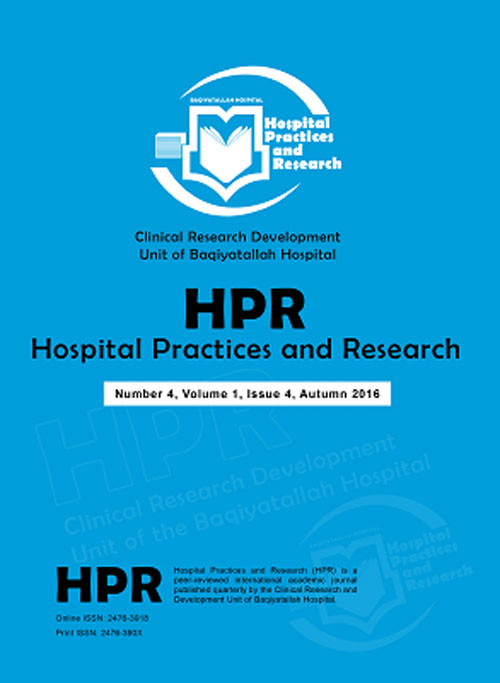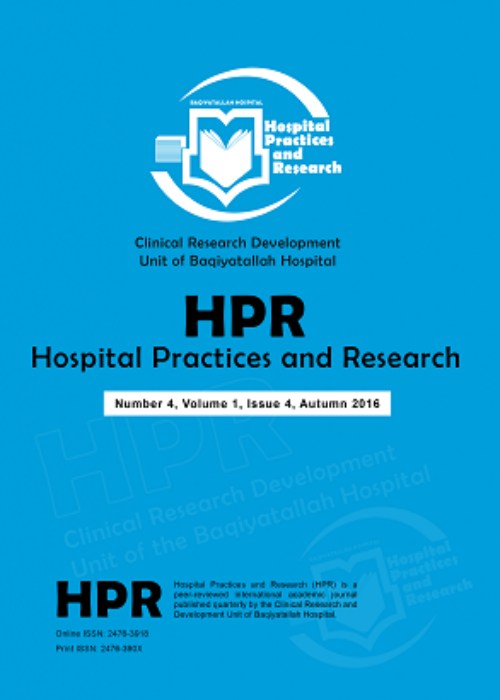فهرست مطالب

Hospital Practices and Research
Volume:1 Issue: 3, Summer 2016
- تاریخ انتشار: 1395/06/12
- تعداد عناوین: 7
-
Pages 79-85BackgroundThere is a renewed interest in job satisfaction among healthcare workers including nurses in Africa and the West African sub-region due to the perception that global shifts in the internal structures and employment practices are inducing changes in the ties that bind employees to their job. Therefore, it is necessary to examine various studies in order to establish an empirical base and utility for the theory of knowledge.ObjectiveThis paper reviewed some of the available literatures on factors affecting job satisfaction among nurses around the world with special focus on the African continent.MethodsElectronic search of Medline, PubMed, Health Internetwork Access to Research Initiative (HINARI), and Google Scholar databases up to 2014 was carried out for studies which analyzed the factors affecting job satisfaction of nurses around the world, Africa and West Africa.ResultsAlthough regional variations in levels of job satisfaction exist among nurses globally, there is more general trend of dissatisfaction and these are because of various factors related to the work environment. Nigerian nurses are generally more satisfied (as high as 92%) with their jobs when compared with their colleagues in other African countries. Socio-demographic and socioeconomic variables do not affect job satisfaction as much as leadership styles, promotion and other features related to the work environment.ConclusionStrong leadership style is a probable reason why nurses in Nigeria are more satisfied with their jobs when compared with their colleagues in other countries even though they may work for longer hours or earn relatively less salaries.Keywords: Leadership, Nursing Management, Hospital Practice
-
Pages 83-86BackgroundAcute appendicitis is one of the most common acute surgery events. Its main treatment is surgery. However medical management before and after the surgery has an important impact on the treatment.ObjectiveThe aim of study was evaluating the outcomes of single dose and quadruple doses of prophylactic antibiotic therapy in patients with acute non-complicated appendicitis.MethodsThis randomized double blind clinical trial was carried out on 294 patients in single dose (136 patients) and the quadruple doses (158 patients) groups. In single dose group, a dose of 1g Cefazolin + 500mg Metronidazole was prescribed intravenously about half an hour before surgery. The quadruple doses group received three more doses after surgery. Two groups were followed for fever, erythema, seroma, wound infection, intra-abdominal abscess formation and readmissions within one month after discharge.ResultsThe mean age of patients was 31±5.14 years. 203(69%) of patients were men while 91(31%) were women. There were no significant statistical differences between groups in age, sex and body mass index (BMI) variables. No significant statistical differences were observed during surgery and hospitalization period between two groups. In the single dose group, wound infection was 8(5.9%), while it was 6(3.8%) in the quadruple doses group; hence, there were no significant statistical differences in this regard. There was no abdominal abscess in groups. There were significant statistical differences regarding erythema, seroma and antibiotics consumption costs between groups.ConclusionA single dose of prophylactic antibiotics is sufficient in patients with acute suppurative non-complicated appendicitis.Keywords: Appendicitis, Appendectomy, Antibiotic Prophylaxis, Wound infection, postoperative complications
-
Pages 87-90BackgroundHospitalization compared to outpatient care leads to better diagnosis. Stability of diagnosis varies among different psychiatric disorders and is associated with some demographic and mental health variables.ObjectiveThe current study evaluated the stability of diagnosis in Baqiyatallah Hospital Psychiatric Ward.MethodsIn this retrospective study, 908 inpatient records from the psychiatric ward of Baqiyatallah Hospital in the years 1997-2015 were randomly selected. Having primary and final diagnoses was the inclusion criterion. Demographic variables (age, sex, marital status, education, and employment) and mental health variables (primary and final psychiatric diagnoses, duration of hospitalization, psychiatric history, and medication history) were recorded. Ultimately, 429 cases were entered into the study.ResultsThe overall diagnostic stability rate was 57.6%. In mood, anxiety, psychotic, and personality disorders, the diagnostic stability rates were 84%, 63.8%, 46.3%, and 36.4%, respectively. For depressive and bipolar disorders, the stability of diagnosis rates were 85.5% and 86%, respectively. A significant relation between diagnosis axis, number of diagnoses, drug abuse and somatic disease history and diagnostic stability was seen (p<0.05).ConclusionAccording to the present study, the maximum diagnostic stability rate was related to mood disorders with anxiety disorders ranking second. The minimum stability was related to personality disorders. Other studies have reported completely different results which may be due to different situations. Future studies in this field seem to be essential.Keywords: diagnosis, Psychiatry, Hospitals
-
Pages 91-93BackgroundOptimal allocation of resources commensurate with performance improvement is the concerns of all countries including Iran. Estimation hospitals production function is important in the economic management of hospitals.ObjectiveThe aim of this study was to estimate the production function of Iranian selected public hospitals as well as analyze the economic behavior in use of hospital resources.MethodsThe study was conducted by using the input data of 67 Iranian selected public hospitals at 2013. In this study, expected production level of hospitals and marginal productivity of inputs were calculated by regression estimation of Cobb-Douglas production function.ResultsThe results showed that a 10% increase in net working hours of specialized human resources in public hospitals would cause 8.8% increase in average production level of inpatient services. Moreover, 10% increase of active beds would cause 1.1% increase in average production level of inpatient services in the studied hospitals. Also, the production levels in 40% of hospitals were lower than the average expected production level and did not have full performance.ConclusionWith the proper utilization of human resources and beds, production level in a significant number of hospitals can be improved.Keywords: Hospitals, Inpatients, Efficiency
-
Pages 95-99BackgroundOutsourcing in healthcare is a cost-effective strategy that reduces costs and increases service quality. Managers must attempt to outsource healthcare services using scientific methods.ObjectiveThis study is a strategic analysis of the outsourcing of health services in one specialty and subspecialty hospital in Tehran.MethodsThis mixed method study (quantitative-qualitative) was performed in 2014 at one of the biggest specialty hospitals in Tehran. Data was collected through interviews, focus discussion groups (FDG), and the internal and external factors evaluation matrix. The study population comprised managers and directors of the hospital. Data was analyzed using Excel 2010 software and SWOT analysis.ResultsThe final scores for internal and external factors were 2.16 and 2.68, respectively, indicating the hospital had a conservative strategic position for choosing outsourcing strategies.ConclusionSince this hospital had a conservative strategic position in outsourcing, managers were able to change their outsourcing strategy while considering its advantages and disadvantages and determining the type of services to be outsourced.Keywords: Outsourcing, Hospital Administration, SWOT
-
Pages 101-102IntroductionMisdiagnosis and the resulting mismanagement are challenging issues in complicated cases which present with obscure complaints. Interpreting radiologic studies, especially conventional plain radiologic images, remains the most frequently prescribed and useful modality for the first step of assessment.Case PresentationIn this report, we present a case of mismanagement of a strange foreign body in the maxillary sinus of a child not found in a facial x-ray.ConclusionInexperienced non-radiologist physicians may make misdiagnoses when reading conventional x-rays.Keywords: Foreign Body, Maxillary Sinus, Plain Radiograph, Radiologist


